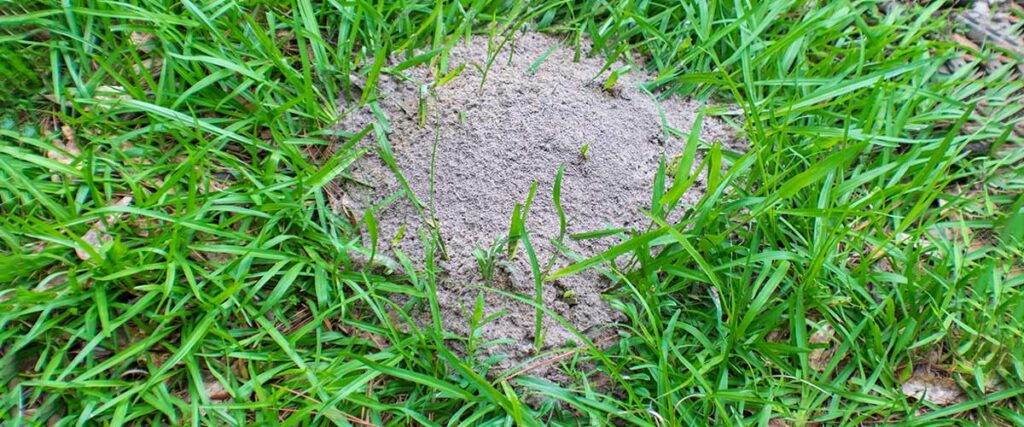

What are Ants?
Ants are captivating social insects that belong to the same family as bees and wasps (Hymenoptera). They create nests that house numerous ants, often ranging from hundreds to even thousands. The majority of ants are wingless, sterile females called workers, while there are also fertile females (queens) and males within the colony. Within Britain, over 30 ant species can be found, with a few of them occasionally appearing in gardens, such as the well-known black garden ant, scientifically known as Lasius niger.
Ants hold a remarkable position among the animal kingdom due to their immense numbers and significant impact on ecosystems worldwide. They have a profound influence on the fauna and flora of entire ecosystems. In garden settings, ants serve as vital predators, while also playing a role in managing greenfly and other aphids. However, it’s important to note that ants can cause disturbances in the soil as well.
How do I know if there are ants in my lawn?
There are several signs that can indicate the presence of ants in your lawn. Here are some common indicators to look out for:
Ant hills: One of the most obvious signs is the presence of ant hills or mounds on the lawn. These small soil mounds, usually conical or dome-shaped, are the result of ants excavating tunnels and chambers underground.


The first signs of an ant’s nest is the formation of small mounds of soil such as those shown above


Ants create mounds when building nests as soil is deposited on the surface
Visible ants: Spotting individual ants crawling on the lawn is another clear indication of their presence. Keep an eye out for ants foraging for food or tending to aphids on plants.
Disturbed soil: If you notice areas of disturbed soil, particularly small pits or openings in the ground, it could be a sign of ants excavating underground tunnels.
Plant damage or aphid infestations: Ants are known to farm aphids for their honeydew. If you observe an unusually high number of aphids on plants in your lawn, it might suggest the presence of ants that are tending to them.
Uneven lawn surface: Ant hills can cause unevenness in the lawn, leading to bumps or small mounds. If you notice such irregularities while walking or mowing the lawn, it could indicate the presence of ants
What issues can ants cause on my lawn?
Ants can potentially cause several issues on lawns. Here are some problems commonly associated with ants in lawns:
Unsightly mounds: Ant hills can create unevenness in the lawn, making it less visually appealing. This can detract from the overall aesthetics of the lawn.
Interference with mowing: Large or numerous ant hills can obstruct the path of lawn mowers, making mowing more challenging and potentially causing damage to the equipment. As the mounds are higher the rest of the lawn, the mower blade will often scalp the top of the mound, leaving unsightly bare patches.
Uneven surface: Ant hills can create bumps and uneven areas on the lawn, which may make it uncomfortable to walk or play on the grass.
Damage to plant roots: Some ant species, such as thatching ants, can construct nests directly beneath the grass surface. This activity can disturb the roots of the lawn, leading to weakened or damaged grass.
Aphid farming: Certain ant species “farm” aphids, protecting them from natural predators and consuming the honeydew they produce. This can lead to an increase in aphid populations, potentially causing damage to plants in the lawn.
Sting or bite potential: While most lawn ants are not aggressive and rarely bite or sting humans, some species, such as Red Ants, can inflict bites if disturbed.
It’s important to note that not all ant species cause significant problems on lawns, and their impact can vary depending on the specific ant species, the size of the colony, and the local environment.
How do I get rid of them?
The most effective method of controlling ants is through the use of pathogenic nematodes. Steinernema feltiae, a parasitic nematode, is the best solution to address ant infestations in lawns and flower beds. These nematodes, which resemble tiny worms, can be applied to the soil in areas where ants are actively bringing soil to the surface. It’s important to note that while this nematode targets ants, it may also have an impact on unintended insects, potentially affecting non-target species.
To purchase nematodes, simply search for Nematodes on the internet.
Here are some other effective strategies you can try:
Remove food sources: Ants are attracted to food, so ensure that any food debris or spills are promptly cleaned up, both indoors and outdoors. This helps to eliminate potential food sources that might be attracting ants to your lawn.
Destroy ant hills: For visible ant hills, you can physically destroy them by carefully digging or raking them to disturb the colony. This can disrupt their nest and population.
Watering and flooding: Certain ant species dislike excessive moisture. Regularly watering your lawn can discourage ants from establishing nests there. Additionally, you can try temporarily flooding ant hills by soaking them with water to encourage ants to relocate.
Natural repellents: There are various natural substances that ants dislike and can act as repellents. Examples include cinnamon, citrus peels, vinegar, or a mixture of water and dish soap. Sprinkle or spray these repellents near ant activity areas or directly on ant hills.
Boric acid bait: A boric acid-based ant bait can be an effective long-term solution. Mix boric acid powder with a sugary substance like powdered sugar or honey to attract ants. Place the bait near ant trails or ant hills, but keep it out of reach of children and pets.
Professional assistance: If the ant infestation persists or is particularly severe, consider contacting a professional pest control service. They can assess the situation and provide targeted treatment options specific to your lawn and the ant species involved.
Remember, it’s important to identify the specific ant species you are dealing with and to choose appropriate control methods accordingly.
Why doesn’t Green Man Lawn Care apply nematodes as part of their service?
As nematodes are living organisms, you should ensure that you store them correctly, apply them at the correct time of year and in the correct conditions. Nematodes need to be applied when the soil is warm. The soil should be kept damp during application and should remain damp for several weeks after.
We recommend that you follow the instructions included in the pack for best results.There are many factors that can affect the overall outcome of using nematodes on a lawn, so it is important that they are applied at the correct time of year and in the correct conditions. This could mean regular watering following application. The correct time of year can change depending on the weather conditions and repeat cycles are more than likely required to get the best results. The products should be used soon after purchase or kept in a fridge as they have a limited shelf life. Bearing in mind all of these factors, we would not be able to provide a cost-effective and reliable enough service.
